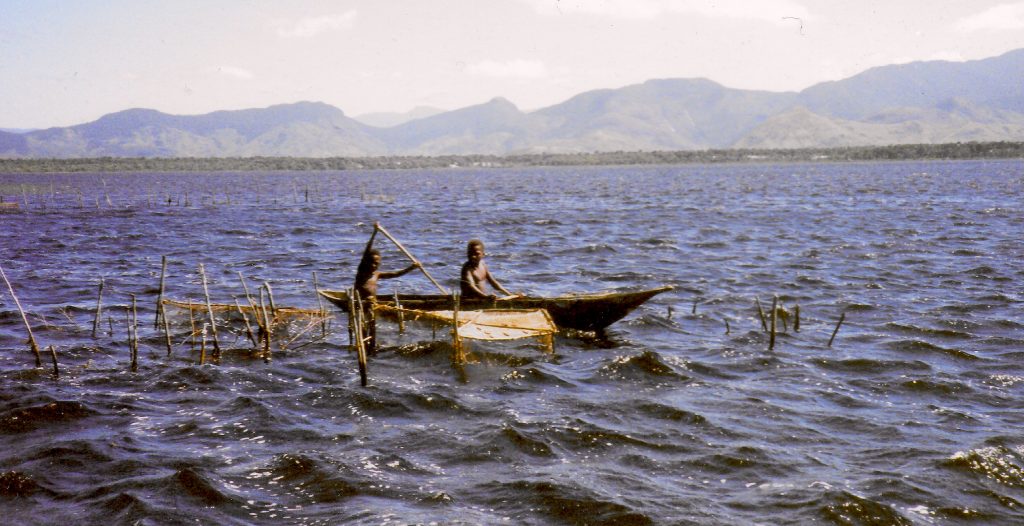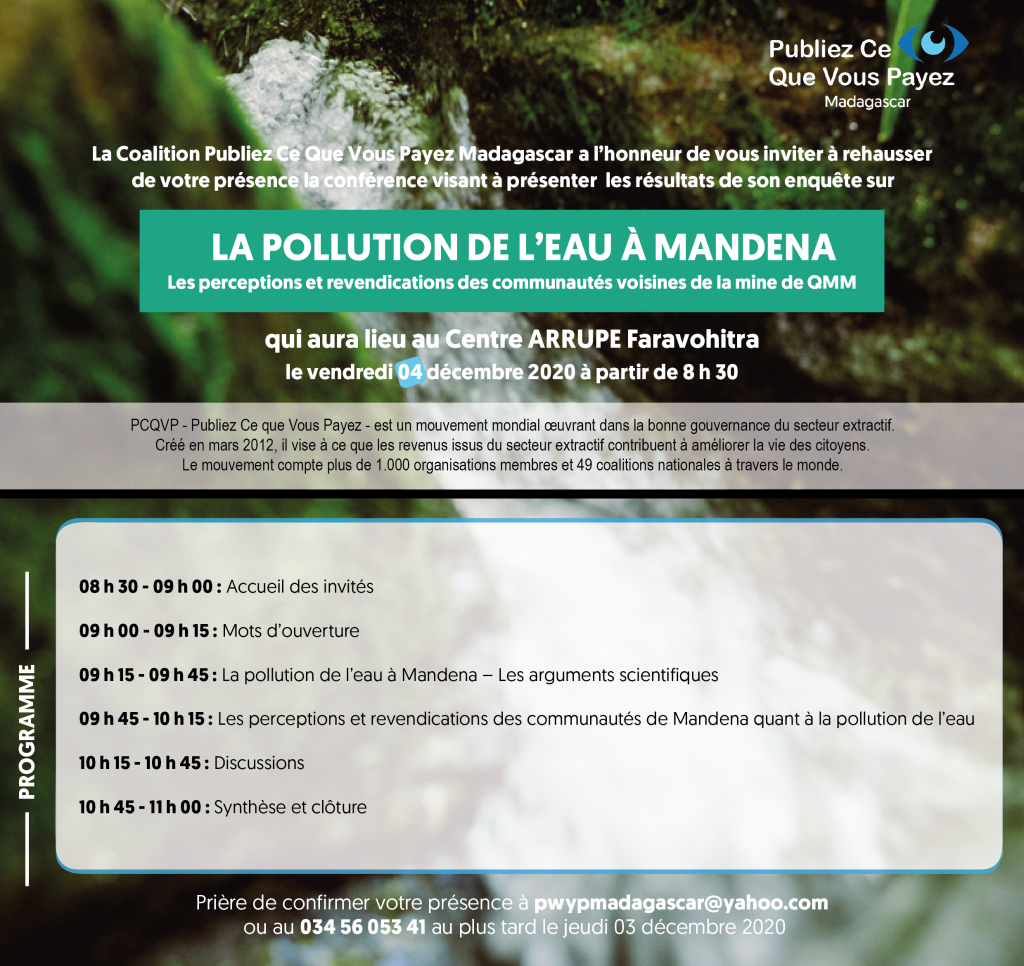
Please see the Andrew Lees Trust’s WATER BRIEFING for the main summary findings from studies conducted between 2018 – 2019
This blog post provides a brief UPDATE regarding the latest water data as well findings from new research into community perceptions of water quality around the QMM mine in Southern Madagascar.
French version of this update available here
Overview
The Rio Tinto QMM mine in south-eastern Madagascar generates radionuclide enriched waters, which it releases through surface discharge and groundwater seepage into the surrounding environment. Independent studies have demonstrated that in some places elevated concentrations of uranium, and lead, exceed WHO safe drinking water guidelines by up to 52 and 40 times, respectively. For the majority of the 15,000 villagers who collect their drinking and domestic water from the lakes and rivers surrounding the QMM mine, a recent survey shows most are concerned about the degradation of water quality over the last ten years and the possible health impacts from pollution.
Joint Action
The Andrew Lees Trust (ALT UK) together with Publish What You Pay (PWYP) in Madagascar and UK, and Friends of the Earth (England, Wales & N Ireland), have jointly collaborated as a group to bring attention to these issues, including via media coverage, blogs and events, advocacy, direct lobbying of the executives at Rio Tinto HQ and, together with the London Mining Network, also at the company’s AGMs. The group has demanded that Rio Tinto recognise QMM’s contamination of local lakes and rivers where thousands of local people collect their domestic and drinking water, that it urgently manages the mine’s waste-waters, and provides access to safe drinking water to the affected communities.
New Water Data and Analyses 2020
Following recommendations made by Dr Stella Swanson (Swanson, 2019), Rio Tinto commissioned a twelve-month radioactivity study by JBS&G at the end of last year. In July 2020, QMM shared the first water data from JBS&G with the group and claimed “all results…were within the relevant WHO guidelines for drinking water quality.”
In order to provide an independent assessment of the data and these conclusions, the Andrew Lees Trust (ALT UK) commissioned Dr Steven Emerman, a hydrology expert, to review the JBS&G study.
Dr Emerman noted that Rio Tinto did not acknowledge the existence of any pre-existing water data in its objectives for the JBS&G study. In this regard, Rio Tinto failed to adhere to standard procedure.
Analysis of the JBS&G water results by Dr Steven Emerman shows that the integration of the new water quality results from JBS&G (2020) with the results from previous studies (Swanson, 2019; Emerman, 2019) strengthens the conclusion of Dr Emerman’s findings (2019) that the QMM mine has a detrimental impact on water quality by showing increases in uranium, thorium and lead in surface water from the upstream to the downstream side of the mine that are statistically significant at better than the 99% confidence level. Please see the new Emerman 2020 report here
He goes on to explain that “Even repeating the new water-quality study 20 times with the same results, and combining the additional results with the existing data, would still yield increases in aqueous uranium and lead from the upstream to the downstream sides of the mine that would be statistically significant at better than the 99% confidence level.”
In concluding his analysis of the JBS&G water report Dr Emerman warns that “the collection of additional data for the sole purpose of reversing the statistical significance of an existing conclusion is not a recommended procedure”.
Access ALT UK’s independent studies here: http://www.andrewleestrust.org/studies_and_reports.html
Community Perceptions and Concerns
A study by Publish What You Pay Madagascar (PWYP MG, November 2020) of the perceptions, concerns and needs of the local communities living around the mine in Mandena concur with the groups’s recommendations and reinforce the demand for safe drinking water.
Over half the population interviewed in a recent study of community perception of water quality around Mandena draw their domestic and drinking water directly from the surrounding lakes and rivers, and more than half of the users of surface water respondents deemed it of poor quality and having been degraded over the past ten years, being either suspicious in colour, bad tasting or foul smelling.
These perceptions were confirmed during focus groups which noted “strong pollution” since the installation of the QMM weir and mining operation. Villagers see that the change in the water quality over the last ten years (since the mine began its operations) has had a detrimental effect on their health, their livelihoods – principally fishing, and consequently on their income.
Local leaders and notables in the three communes perceive the water to have bad effects on the health of the population, and a significant number attribute the degradation of the water quality to proximity to the QMM mine operations (extraction of the sands). More than half of the respondents reported health problems in relation to local water consumption, and almost all who draw their water from surface water reported health issues related to water, with over half perceiving the mine to be responsible for the poor quality of water (due to mine waste).Contamination of their water source is a principle concern of the communities. More than half of those surveyed have already taken their concerns to the local authorities, and/or to QMM. However, the researchers observe from the discussions with villagers that locals fear repression and/or imprisonment for making complaints. Please see the PWYP MG Mandena report.
Almost all those villagers who use surface water sources want support for and restitution of access to good quality water. A number also claim they want compensation for damage done and remediation for the impacts of polluted water.

Recommendations and Requests for Safe Drinking Water
Dr Emerman emphasises that “enough data have been collected by both the mining company and the community to show the need for Rio Tinto to prevent further discharge of contaminated mine water and to provide appropriate water treatment to the community without further delay, especially considering the potentially serious consequences of uranium and lead poisoning”.
Dr Swanson recommended that Rio Tinto provide safe drinking water to communities in her 2019 report. She has cautioned that “it is certainly too early to dismiss the possibility that uranium and other metals pose a risk to human health”[1].
International experts, Malagasy civil society (PWYP MG, CRAADO-OI/COLLECTIF TANY, Plate-Forme Nationale des Organisations de la Société Civile de Madagascar PFNOSCM), international NGOs and environmental campaigners (ALT UK, PWYP UK and Friends of the Earth/Craig Bennett) and local communities in Mandena, have all raised concerns, made clear recommendations and demanded investigations into the QMM mine concerning the fears around its impact on the environment, local governance, water contamination and local communities’ health and livelihoods.
Rio Tinto must accept responsibility for the elevated levels of uranium, thorium and lead related to its QMM mine operation in Anosy region, transparently demonstrate how it will manage the QMM wastewaters more effectively, and immediately provide safe drinking water to local communities.
[1] Email correspondence from Swanson to ALT UK August 2020.

Pingback: Deadly dams, and victory over Dewley Hill mine - London Mining Network